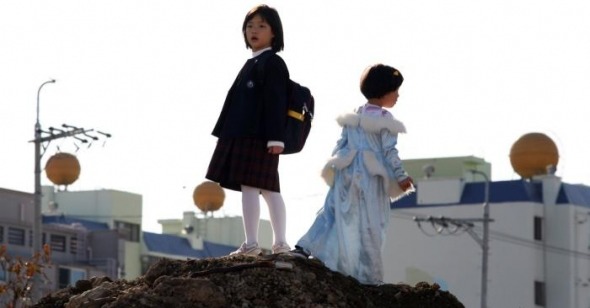In a Lonely Place
by Kristi Mitsuda
Treeless Mountain
Dir. So Yong Kim, U.S., Oscilloscope Laboratories
So Yong Kim’s cinema can break your heart. Not by invoking the usual tearjerking music swells and dramatic crescendos, but by constructing narratives authentically attuned to the behavioral and emotional rhythms of particular age groups, from childhood to teenage years. In the course of only two films—the impeccable adolescent tale In Between Days being the first—Kim has demonstrated a mastery of the medium similar to Ramin Bahrani; both directors craft character stories and share realist aesthetic tendencies, evincing an almost anthropological attention to detail whilst weaving immigrant experiences into the fabric of a shared American narrative. Treeless Mountain again sees Korean-American director Kim—drawing upon memories of growing up in Pusan—expertly turning her gaze upon a female protagonist, this time undergoing an experience more harrowing than high school.
Many of the particulars integral to the success of In Between Days are on full display in Treeless Mountain, not least a naturalistic nonactor in the lead role. Played by Hee Yeon Kim, six-year-old Jin is first introduced to us at her school desk attentively noting her teacher’s matter-of-fact instruction, “When you get home, take a clock out for practice and have your mother teach you how time works.” We later see her finish the homework on her own after picking up her younger sister, Bin (the delightful Song Hee Kim), from a neighbor’s house. Kim thus economically establishes the situation, further expanded upon when Jin and Bin’s mom (Soo Ah Lee) arrives home, single-parent exhaustion apparent immediately. Jin, possessing a sensitivity and outer awareness unusual for her age—no doubt attributable in part to her father’s abandonment—inquires about a secretive exchange she witnesses between her mother and landlady. She’s heard this song before, and exudes apprehensive understanding when she comes home the next day to find her mother packing up the apartment.
An impromptu visit to “Big Aunt” (Mi Hyang Kim) confirms Jin’s fears: mother tells daughter she’s going to look for her father. Mother gives the girls a piggy bank present and a promise to return once it’s full. While Bin is too young to understand the full implications, Jin sees a repeat of the past; her understandable, literal abandonment issues leave her wide-eyed and silent in reaction to a goodbye request to “Take care of Bin for me,” betraying her own question: Who will take care of me? On their last night in the apartment, Jin wakes her mother up and confesses to wetting the bed; she cries softly as her mother patiently towels her off and consoles, “We’ll keep it between us. It’s fine. Go sleep on my side.” The tenderness of this response is harshly upended later when Big Aunt shames the girls after another accident (Jin allows Bin to take the blame), a moment which throws Jin’s longing for her mother into relief.
When not cleaning up around the house under Big Aunt’s direction, the girls spend their days roaming around the neighborhood, local market, and outlying fields, Jin perpetually in a grey tracksuit and Bin in a blue princess gown. After their negligent aunt drunkenly passes out one night before feeding the girls, Jin decides the next day to take action; the sisters embark upon an entrepreneurial enterprise, grilling grasshoppers and selling them on the street in order to more quickly fill the piggy bank and call back their mother. In their ramblings around the neighborhood, Bin befriends another young boy whose mother offers the girls milk and cookies, encourages her son to share his stickers with them. Jin, however, is unwilling to accept too much of this well-meaning attention; wary of a substitute maternal figure coming in to replace her or Bin’s memory of their mother, she constantly cuts short the visits.
Treeless Mountain unfolds for the most part in extreme close-ups, allowing for the precise expression of Jin’s intermittently waxing and then waning hopes, her fleeting inspirations, calculations, anxieties, expectations; watching the young nonprofessional’s face morph from mortification to marvel is a revelation. Such a claustrophobic shooting style feels appropriate for the girls’ enclosed world, the limits of which become acutely known to Jin after knocking at a friend’s door only to meet his mother’s reminder that he’s in school—don’t the girls go to school? Numerous shots also capture Jin and Bin peering out of windows, and a mournful tone haunts the frequent dusky shots of the horizon, another day passing in which their mother doesn’t return. Lingering over the bodies of the listless sisters after they come to the realization that a full piggy bank isn’t a genie in a bottle, Kim makes palpable their sorrow simply, through careful composition and pacing; later, a joyful endpoint is just as subtly expressed through lighting. Skillfully steering clear of sentimentality in relaying her semiautobiographical tale—not just of childhood but also of women—the director creates a raw portrait that’s exquisite in its miniaturist scope.
(This article originally appeared on indieWIRE.)
